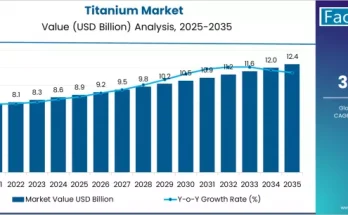The global fiberglass fabric market is poised for significant growth, supported by rising demand from aerospace, construction, automotive, and renewable energy industries. According to a recent report by Fact.MR, the market is projected to increase from USD 11,827 million in 2024 to USD 25,434 million by 2035, expanding at a strong CAGR of 7.2% during the forecast period.
As industries accelerate the adoption of lightweight, durable, and high-strength materials, fiberglass fabrics are emerging as a preferred reinforcement solution for composite manufacturing, insulation, and structural applications.
Strategic Market Drivers
- Expanding Aerospace and Defense Applications
The aerospace sector remains a dominant growth catalyst for the fiberglass fabric market. Aircraft manufacturers increasingly rely on fiberglass composites for structural components, radomes, and insulation panels due to their superior strength-to-weight ratio and thermal resistance.
With the rising demand for fuel-efficient aircraft and electric aviation advancements, fiberglass fabrics play a pivotal role in enhancing performance and reducing operational costs.
- Growing Use in Wind Energy and Infrastructure
The rapid expansion of renewable energy infrastructure—particularly wind power generation—is driving large-scale adoption of fiberglass fabrics for turbine blade manufacturing. Their lightweight nature and corrosion resistance make them ideal for long-term outdoor applications.
In the construction sector, fiberglass fabrics are gaining traction for reinforcement in concrete structures, roofing, and insulation systems, ensuring durability and sustainability in modern infrastructure projects.
- Automotive Lightweighting and Thermal Insulation
The global shift toward electric and hybrid vehicles (EVs) is fueling demand for fiberglass fabrics in automotive components, including body panels, battery enclosures, and underbody shields. These fabrics provide excellent heat resistance and dimensional stability, supporting efforts to enhance vehicle efficiency and passenger safety.
- Increasing Adoption in Electronics and Industrial Applications
In the electronics sector, fiberglass fabrics serve as key reinforcement materials in printed circuit boards (PCBs) and insulation systems. Their electrical non-conductivity, dimensional stability, and flame retardancy make them indispensable for high-performance electronic devices and industrial machinery.
Regional Growth Highlights
East Asia: The Manufacturing and Export Hub
East Asia dominates global fiberglass fabric production and consumption, with China, Japan, and South Korea leading in composite material innovation and manufacturing scale. Expanding automotive production, infrastructure projects, and renewable energy installations continue to propel regional demand.
North America: Innovation and Advanced Composites
The U.S. and Canada are witnessing accelerated adoption of fiberglass fabrics across aerospace, defense, and wind energy sectors. Technological advancements in composite processing and strong investments in sustainable manufacturing further strengthen the region’s market position.
Europe: Sustainability-Driven Growth
Europe’s stringent environmental regulations and green energy targets are shaping a strong market for eco-friendly and recyclable fiberglass composites. Countries like Germany, France, and the U.K. are leading in research and application of fiberglass materials for modular construction, automotive, and offshore wind projects.
Emerging Markets: Rising Industrialization and Energy Demand
Regions such as Latin America, the Middle East, and South Asia are emerging as high-potential markets, fueled by rapid industrialization, infrastructure development, and renewable energy investments. Local manufacturing initiatives and public infrastructure projects are expected to accelerate fiberglass fabric consumption in the coming decade.
Market Segmentation Insights
By Fabric Type
- Woven Fiberglass Fabric: Widely used for structural reinforcement in composites and construction.
- Non-Woven Fiberglass Fabric: Gaining popularity in insulation and filtration applications due to enhanced flexibility.
- Specialty Fiberglass Fabric: Designed for high-performance uses in aerospace, defense, and industrial sectors.
By End-Use Industry
- Aerospace & Defense – Dominant segment due to performance-critical applications.
- Building & Construction – Increasing use for reinforcement, waterproofing, and insulation.
- Automotive & Transportation – Growing adoption for lightweight structural components.
- Electrical & Electronics – Integral in circuit boards and insulating materials.
- Energy & Industrial – Expanding role in wind turbines and heavy-duty industrial equipment.
Challenges and Market Considerations
- High Production Costs: Advanced fabrication processes and quality control increase operational expenses.
- Competition from Carbon Fiber and Aramid Materials: High-performance alternatives may limit market penetration in specific applications.
- Environmental Regulations: Recycling challenges and energy-intensive manufacturing require innovation in eco-friendly processing.
- Supply Chain Disruptions: Fluctuating glass fiber raw material prices and logistics constraints can impact production stability.
Competitive Landscape
The fiberglass fabric market is characterized by technological innovation and strategic expansion. Leading companies are focusing on enhancing product performance, developing sustainable solutions, and strengthening global supply networks.
Key Companies Profiled:
- Hexcel Corporation
- Owens Corning
- Saint-Gobain
- Chomarat Group
- Jushi Group Co., Ltd.
- Saertex GmbH & Co. KG
- Tah Tong Textile Co., Ltd.
- Binani 3B-the Fibreglass Company
- Nitto Boseki Co., Ltd.
- Nippon Electric Glass Co., Ltd.
Recent Developments
- March 2025 – Hexcel Corporation announced a collaboration with FIDAMC (Foundation for the Research and Development of Composite Materials) to advance composite material performance and sustainability across industries.
- January 2025 – Hexcel Corporation showcased its latest aerospace composite innovations at Aero India 2025, reinforcing its leadership in lightweight and high-strength material technologies.
Future Outlook: Toward Smart and Sustainable Composite Solutions
The coming decade will see the fiberglass fabric industry evolving toward sustainability, smart manufacturing, and multi-functional performance. Manufacturers are investing in bio-based resins, recyclable composites, and AI-driven quality control systems to meet global demand for efficient and eco-friendly solutions.
With expanding applications across aerospace, energy, construction, and mobility, the fiberglass fabric market is set for dynamic and sustained growth. Companies that embrace innovation, collaboration, and circular economy principles will define the next generation of high-performance composite materials powering a more sustainable and resilient global economy.



